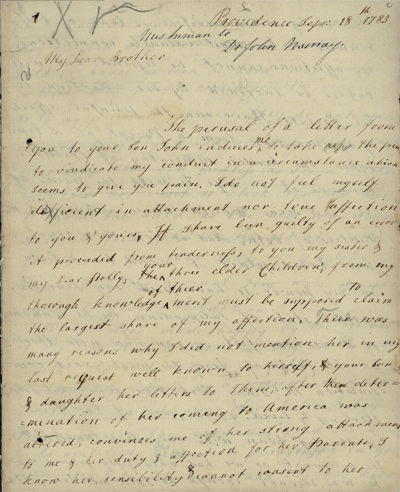
|
|
Elizabeth Murray Inman to John Murray, 18 September 1783. In this letter, full of family news, Elizabeth responds to apparent criticism from her older brother John, a doctor in Norwich, England, of her earlier actions in bringing his daughter Polly to America. Although John's letter does not exist, it is clear from Elizabeth's response that she believed he was accusing her of forcing an unnecessary sacrifice on Polly by arranging for her to leave her family in the spring of 1770 to keep shop in Boston. On pages three and four, she alludes to his comments suggesting that Polly had taken a step down by shopkeeping. Elizabeth defends herself against this charge and points out the success she met as a shopkeeper, recalling with gratitude her own "spirit of Independence." This letter contains references to several members of Murray’s extended family. “Anne” is Anne Murray Powell, John’s daughter who kept shop along with Polly in Boston in the early 1770s. “Mr I” is Ralph Inman, Elizabeth Murray’s third husband. “Mr Clark” is her nephew, John Innes Clark, a prominent merchant and the son of her sister Barbara. “Mrs Forbes” is her niece, Dolly Murray Forbes, the daughter of James Murray. “Mrs Barnes” is her good friend Christian Barnes, who became part of the Loyalist exiles community in England. “Mr Bridgen” is Edward Bridgen, an old friend and merchant in London.
|
||
|
|||
 Elizabeth Murray Inman to John Murray, 18 September 1783, J.M. Robbins Papers, Courtesy, Massachusetts Historical Society. Page 1
Elizabeth Murray Inman to John Murray, 18 September 1783, J.M. Robbins Papers, Courtesy, Massachusetts Historical Society. Page 1
